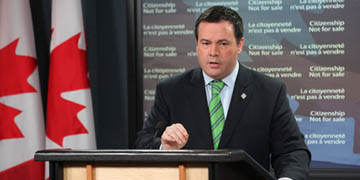

Canada has not become ugly and
intolerant
We're still a pluralistic nation and welcome legitimate migrants; recent government reforms are about tackling abuse
Jason Kenney
The Guardian, Thursday 27 September 2012 19.34 BST

‘Canada consistently records the highest levels of public tolerance for ethnic, religious and cultural diversity in the developed world.' Photograph: Dave Reede/Corbis
Jonathan Kaiman depicts an increasingly ugly and intolerant Canada characterised by wanton environmental despoliation and paralysing political soul-searching (Maple leaf ragged: what ails Canada?, 15 September). I suspect this verdict would surprise the nine out of 10 Canadians who recently told pollsters that "Canada is the greatest country in the world".
It would also confound the many observers who recognise Canada's global economic leadership, with the strongest fiscal position in the G8.
I will confine myself to correcting Kaiman's slanders against the most open and generous immigration system in the developed world. He claims that we are "tightening" immigration. In fact, our government has increased immigration to the highest sustained level in Canadian history, and the highest per-capita level in the developed world. He writes that we have "radically adjusted the criteria for successful applications", when in fact we are making our system more flexible, allowing skilled tradesmen, semi-skilled workers and foreign students to become permanent residents for the first time. He claims that we "cut resettlement programmes en masse", when in fact we are increasing our refugee resettlement programmes by 20% and have tripled funding for their integration.
Kaiman wrongly suggests that we have "eliminated all but the most basic healthcare for most refugee groups", when in fact we will continue to fund healthcare for most refugees – such as those resettled from UN camps – more generously than Canada's general health service. He bemoans a fictitious "harsh crackdown on illegal immigrants", suggesting that there is something untoward about seeking to remove citizenship from people who obtained it fraudulently and have never lived in Canada. Far from "harsh", those who contest our efforts have access to an extensive process of judicial reviews and appeals.
Kaiman laments our refusal rate for citizenship when, in fact, our overall acceptance rate last year was 92%. We are also proud to have the highest naturalisation rate in the developed world, with 85% of permanent residents eventually becoming full citizens. Finally, Kaiman imagines that the number of immigrants to Canada from China and India has halved in the last six years, when in fact it has remained constant, with an annual average of 28,000 permanent residents from India, and an annual average of 30,000 permanent residents from China between 2006 and 2010 (the last full year of available data).
Kaiman's imaginary 50% reduction in Asian immigration is the basis of his most outrageous claim, that "the changes point to a deep-rooted, yet widely ignored undercurrent of racism in Canadian society". While no society can claim to be entirely free of prejudice, Canada is the only major western democracy without a xenophobic or anti-immigration political movement, and consistently records the highest levels of public tolerance for ethnic, religious and cultural diversity in the developed world.
Canada is frequently lauded as a model of peaceful pluralism. Our government's recent reforms have made Canada more open to legitimate immigrants but harder on those seeking to abuse our generosity. It is a pity that Kaiman has aligned himself with the radical fringe of racial grievance-mongers in mistaking the rule of law – the backbone of a free and open society – for discrimination.